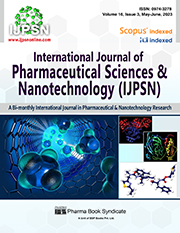2D & 3D-QSAR Studies on a Series of Quinoline-Amino-piperidine Derivatives as Potent Mycobacterium DNA-Gyrase-B Inhibitors
DOI:
https://doi.org/10.37285/ijpsn.2023.16.3.5Abstract
Introduction: Mycobacterium tuberculosis is a familiar infectious bacillus that causes tuberculosis, which primarily affects the lungs and the spinal cord. To combat the growing difficulties in treating MTB, it is necessary to create safe medications with novel mechanisms of action.
Objective: To design and develop some novel quinolone-amino piperidine derivatives with potent mycobacterium DNAgyraseB inhibitory using the QSAR technique.
Methods: Multiple linear regression (MLR), partial least squares (PLS), and k-nearest neighbour molecular field analysis ((kNN-MFA) were utilised in the development of 2D and 3D-QSAR models, respectively; these models were then validated.
Results: The recently developed 2D-QSAR model can explain 85.07% (r2 = 0.8507) of the total variance incorporated into the training set. In addition, the model has an internal prediction capacity (q2) of 77.65% and an external prediction capacity (pred r2) of 83.64%, respectively. The F test confirms that the likelihood of the model failing is extremely low. The 3D-QSAR model explains the values of k (2), q2 = 0.5707, pred r2 = 0.7843, q2 se = 0.3167, and pred r2 se = 0.3111. This demonstrates that the QSAR equation obtained in that way is statistically significant and that the model has a predictive capacity of 78.43%.
Conclusion: The robustness of the developed 2D or 3D-QSAR models provides the necessary information and is expected to provide an excellent option for drug design.
Downloads
Metrics
Keywords:
Mycobacterium tuberculosis, Quinoline, DNA Gyrase, QSAR, MLR, PLS, CNNDownloads
Published
How to Cite
Issue
Section
References
Kaufman SHE, Rubin E. Mycobacterium tuberculosis: Life and Death in the phagosome. In Handbook of Tuberculosis 2008 (pp 307-317). WILEY, Weinheim.
Global Tuberculosis Report. World Health Organization 2021 (pp 31-32). Geneva, Switzerland.
Burman WJ. Development of tuberculosis treatment in the 21st century. Clinical Infectious Diseases. 2010 May 15;50(3):165-172
Dye C, Williams BG. The population dynamics and control of tuberculosis. Science. 2010 May 14;328:856-861.
Atanasov AG, Sergey BZ, Dirsch VM. Natural products in drug discovery: advances and opportunities. Nature Reviews Drug Discover. 2021 Jan 28;20: 200-216.
Newman DJ, Cragg GM. Natural Products as Sources of New Drugs over the Nearly Four Decades from 01/1981 to 09/2019. Journal of Natural Products. 2020 Mar 12:83(3);770-803.
Jain S, Chandra V, Jain PK, Pathak K. Comprehensive review on current developments of quinoline-based anticancer agents. Arabian Journal of Chemistry. 2019 Oct 26;12(8):4920-4946.
Keri RS, Patil SA. Quinoline: A promising antitubercular target. Biomedicine and Pharmacotherapy. 2014 Oct 29;68(8):1161-1175.
Sharma G, Jha AK, Vaishnav Y. 2D QSAR analysis on substituted pyrrolidine derivatives as dipeptidyl peptidase-iv inhibitors. Journal of Cardiovascular Disease Research. 2021 Mar;12(3): 2039-2053.
Kasmi R, Hadaji E, Chedadi O. 2D-QSAR and docking study of a series of coumarin derivatives as inhibitors of CDK (anticancer activity) with an application of the molecular docking method. Heliyon. 2020 Aug 10; 6(8):1-11.
Alam S, Khan F. 3D-QSAR, docking, ADME/Tox studies on flavone analogs reveal anticancer activity through tankyrase inhibition, Science Reports. 2019 Apr 01; 9:1-15.
Medapi B, Janupally R, Saxena S. Design and synthesis of novel quinoline–aminopiperidine hybrid analogues as Mycobacterium tuberculosis DNA gyraseB inhibitors, Bioorganic & Medicinal Chemistry. 2015 Mar 9;23(9):2062-2078.
Golbraihk A, Muratov E, Fourches D, Tropsha A. Dataset modelability by QSAR. Journal of Chemical Information Modeling. 2014 Jan 27;54(1):1-4.
Bhadoriya KS, Kumawat NK, Jain SV. Exploring 2D and 3D QSARs of benzimidazole derivatives as transient receptor potential melastatin 8 (TRPM8) antagonists using MLR and kNN-MFA methodology. Journal of Saudi Chemical Society. 2012 Nov 3; 20:256-270.
Saxena AK, Prathipati P. Comparison of MLR, PLS and GA-MLR in QSAR analysis. SAR QSAR In Environmental Research. 2007 Feb 1;14(5-6): 433-445.
Pagare AH, Kankate RS, Shaikh AR. 2D and 3D QSAR using kNN-MFA method of the novel 3, 4-dihydropyrimidin-2(1H)-one urea derivatives of N-aryl urea as an antifungal agents. Journal of Current Pharma Research. 2015 Mar 22; 5(2):1473-1481.
Jain SV, Ghate M, Bhadoriya KS, Bari SB, Chaudhari A, Borse JS. 2D, 3D-QSAR and docking studies of 1,2,3-thiadiazole thioacetanilides analogues as potent HIV-1 non-nucleoside reverse transcriptase inhibitors. Organic and Medicinal Chemistry Letters. 2012 Jun 12;22(2):1-13.






